Assessing Language Lateralization through Gray Matter Volume: Implications for Preoperative Planning in Brain Tumor Surgery
Abstract
1. Introduction
2. Materials and Methods
2.1. Participants
2.2. MRI Acquisition
2.3. Functional MRI Language Tasks and Language Lateralization Determination
2.4. ROI-Based Morphometry Analysis
2.5. Statistical Analyses
3. Results
3.1. Demographic Comparisons
3.2. Linear Regression
3.2.1. Healthy Participants
3.2.2. Participants with Brain Tumor in the Left Hemisphere
3.3. Logistic Regression
3.3.1. Healthy Participants
3.3.2. Left-Hemisphere Brain Tumor Participants
4. Discussion
5. Conclusions
Supplementary Materials
Author Contributions
Funding
Institutional Review Board Statement
Informed Consent Statement
Data Availability Statement
Conflicts of Interest
References
- Agarwal, S.; Sair, H.I.; Gujar, S.; Pillai, J.J. Language mapping with fMRI: Current standards and reproducibility. Top. Magn. Reson. Imaging 2019, 28, 225–233. [Google Scholar] [CrossRef] [PubMed]
- Benjamin, C.F.; Walshaw, P.D.; Hale, K.; Gaillard, W.D.; Baxter, L.C.; Berl, M.M.; Polczynska, M.; Noble, S.; Alkawadri, R.; Hirsch, L.J.; et al. Presurgical language fMRI: Mapping of six critical regions. Hum. Brain Mapp. 2017, 38, 4239–4255. [Google Scholar] [CrossRef] [PubMed]
- Partovi, S.; Jacobi, B.; Rapps, N.; Zipp, L.; Karimi, S.; Rengier, F.; Stippich, C. Clinical standardized fMRI reveals altered language lateralization in patients with brain tumor. Am. J. Neuroradiol. 2012, 33, 2151–2157. [Google Scholar] [CrossRef] [PubMed]
- Toga, A.W.; Thompson, P.M. Mapping brain asymmetry. Nat. Rev. Neurosci. 2003, 4, 37–48. [Google Scholar] [CrossRef] [PubMed]
- Saur, D.; Lange, R.; Baumgaertner, A.; Schraknepper, V.; Willmes, K.; Rijntjes, M.; Weiller, C. Dynamics of language reorganization after stroke. Brain 2006, 129, 1371–1384. [Google Scholar] [CrossRef]
- Ruff, I.M.; Petrovich Brennan, N.M.; Peck, K.K.; Hou, B.L.; Tabar, V.; Brennan, C.W.; Holodny, A.I. Assessment of the language laterality index in patients with brain tumor using functional MR imaging: Effects of thresholding, task selection, and prior surgery. Am. J. Neuroradiol. 2008, 29, 528–535. [Google Scholar] [CrossRef]
- Seghier, M.L. Laterality index in functional MRI: Methodological issues. Magn. Reason. Imaging 2008, 26, 594–601. [Google Scholar] [CrossRef]
- Thakkar, I.; Arraño-Carrasco, L.; Cortes-Rivera, B.; Zunino-Pesce, R.; Mery-Muñoz, F.; Rodriguez-Fernández, M.; Mendez-Orellana, C. Alternative language paradigms for functional magnetic resonance imaging as presurgical tools for inducing crossed cerebro-cerebellar language activations in brain tumor patients. Eur. Radiol. 2022, 32, 300–307. [Google Scholar] [CrossRef]
- Jalloul, M.; Miranda-Schaeubinger, M.; Noor, A.M.; Stein, J.M.; Amiruddin, R.; Derbew, H.M.; Mango, V.L.; Akinola, A.; Hart, K.; Weygand, J.; et al. MRI scarcity in low-and middle-income countries. NMR Biomed. 2023, 36, e5022. [Google Scholar] [CrossRef]
- Mendez-Orellana, C.M.; Visch-Brink, E.G.; Vernooij, M.; Kalloe, S.; Satoer, D.; Vincent, A.; Smits, M. Crossed cerebrocerebellar language lateralization: An additional diagnostic feature for assessing atypical language representation in presurgical functional MR imaging. Am. J. Neuroradiol. 2015, 36, 518–524. [Google Scholar] [CrossRef]
- Bargalló, N.; Cano-López, I.; Rosazza, C.; Vernooij, M.W.; Smits, M.; Vitali, P.; Alvarez-Linera, J.; Urbach, H.; Mancini, L.; Ramos, A.; et al. Clinical practice of language fMRI in epilepsy centers: A European survey and conclusions by the ESNR Epilepsy Working Group. Neuroradiology 2020, 62, 549–562. [Google Scholar] [CrossRef] [PubMed]
- Chang, C.Y.; Peck, K.K.; Brennan, N.M.; Hou, B.L.; Gutin, P.H.; Holodny, A.I. Functional MRI in the presurgical evaluation of patients with brain tumors: Characterization of the statistical threshold. Stereotact. Funct. Neurosurg. 2010, 88, 35–41. [Google Scholar] [CrossRef] [PubMed]
- Roux, F.E.; Boulanouar, K.; Lotterie, J.A.; Mejdoubi, M.; LeSage, J.P.; Berry, I. Language functional magnetic resonance imaging in preoperative assessment of language areas: Correlation with direct cortical stimulation. Neurosurgery 2003, 52, 1335–1347. [Google Scholar] [CrossRef] [PubMed]
- Wellmer, J.; Weber, B.; Urbach, H.; Reul, J.; Fernandez, G.; Elger, C.E. Cerebral lesions can impair fMRI-based language lateralization. Epilepsia 2009, 50, 2213–2224. [Google Scholar] [CrossRef] [PubMed]
- Jones, S.E.; Mahmoud, S.Y.; Gonzalez-Martinez, J.; Lockwood, D.S.; Moon, D.; Smith, A.S.; Phillips, M.D. Application of a computerized language lateralization index from fMRI by a group of clinical neuroradiologists. Am. J. Neuroradiol. 2013, 34, 564–569. [Google Scholar] [CrossRef]
- Wood, A.G.; Harvey, A.S.; Wellard, R.M.; Abbott, D.F.; Anderson, V.; Kean, M.; Saling, M.M.; Jackson, G.D. Language cortex activation in normal children. Neurology 2004, 63, 1035–1044. [Google Scholar] [CrossRef]
- Ashburner, J.; Friston, K.J. Voxel-based morphometry—The methods. Neuroimage 2000, 11, 805–821. [Google Scholar] [CrossRef]
- Green, D.W. Exploring cross-linguistic vocabulary effects on brain structures using voxel-based morphometry. Biling. Lang. Cogn. 2007, 10, 189–199. [Google Scholar] [CrossRef]
- Mechelli, A.; Crinion, J.T.; Noppeney, U.; O’Doherty, J.; Ashburner, J.; Frackowiak, R.S.; Price, C.J. Structural plasticity in the bilingual brain. Nature 2004, 431, 757. [Google Scholar] [CrossRef]
- Dorsaint-Pierre, R.; Penhune, V.B.; Watkins, K.E.; Neelin, P.; Lerch, J.P.; Bouffard, M.; Zatorre, R.J. Asymmetries of the planum temporale and Heschl’s gyrus: Relationship to language lateralization. Brain 2006, 129, 1164–1176. [Google Scholar] [CrossRef]
- Josse, G.; Kherif, F.; Flandin, G.; Seghier, M.L.; Price, C.J. Predicting language lateralization from gray matter. J. Neurosci. 2009, 29, 13516–13523. [Google Scholar] [CrossRef] [PubMed]
- Zhang, N.; Xia, M.; Qiu, T.; Wang, X.; Lin, C.; Guo, Q.; Lu, J.; Wu, Q.; Zhuang, D.; Yu, Z.; et al. Reorganization of cerebro-cerebellar circuit in patients with left hemispheric gliomas involving language network: A combined structural and resting-state functional MRI study. Hum. Brain Mapp. 2018, 39, 4802–4819. [Google Scholar] [CrossRef] [PubMed]
- Almairac, F.; Duffau, H.; Herbet, G. Contralesional macrostructural plasticity of the insular cortex in patients with glioma. Neurology 2018, 91, e1902–e1908. [Google Scholar] [CrossRef] [PubMed]
- Duffau, H. Lessons from brain mapping in surgery for low-grade glioma: Insights into associations between tumor and brain plasticity. Lancet Neurol. 2005, 4, 476–486. [Google Scholar] [CrossRef] [PubMed]
- Orellana, C.M.; Visch-Brink, E.G.; De Jong-Hagelstein, M.; Koudstaal, P.; van der Lugt, A.; Smits, M. Decreased relative contribution to language processing of the right hemisphere after language therapy assessed with fMRI in chronic aphasia patients. Eur. Congr. Radiol.-ECR 2012. [Google Scholar] [CrossRef][Green Version]
- Dym, R.J.; Burns, J.; Freeman, K.; Lipton, M.L. Is functional MR imaging assessment of hemispheric language dominance as good as the Wada test?: A meta-analysis. Radiology 2011, 261, 446–455. [Google Scholar] [CrossRef]
- Méndez-Orellana, C.; Arraño-Carrasco, L.; Cortés-Rivera, B.; Sandoval-León, K.; Lorenzoni-Santos, J.; Villanueva-Garín, P.; Rojas-Valdivia, R.; Méndez-Ortega, T.; Monsalve-Rosales, J.; Flores-Kruuse, P.; et al. Evaluación de la actividad cerebro-cerebelar cruzada para determinar la lateralidad del lenguaje en pacientes con tumores cerebrales. Rev. Médica Chile 2021, 149, 689–697. [Google Scholar] [CrossRef]
- Albayay, J.; Villarroel-Gruner, P.; Bascour-Sandoval, C.; Parma, V.; Gálvez-García, G. Psychometric properties of the Spanish version of the Edinburgh Handedness Inventory in a sample of Chilean undergraduates. Brain Cogn. 2019, 137, 103618. [Google Scholar] [CrossRef]
- Jansen, A.; Flöel, A.; Van Randenborgh, J.; Konrad, C.; Rotte, M.; Förster, A.F.; Deppe, M.; Knecht, S. Crossed cerebro-cerebellar language dominance. Hum. Brain Mapp. 2005, 24, 165–172. [Google Scholar] [CrossRef]
- Keller, S.S.; Roberts, N.; Baker, G.; Sluming, V.; Cezayirli, E.; Mayes, A.; Eldridge, P.; Marson, A.G.; Wieshmann, U.C. A voxel-based asymmetry study of the relationship between hemispheric asymmetry and language dominance in Wada tested patients. Hum. Brain Mapp. 2018, 39, 3032–3045. [Google Scholar] [CrossRef]
- Rasmussen, T.; Milner, B. The role of early left-brain injury in determining lateralization of cerebral speech functions. Ann. N. Y. Acad. Sci. 1977, 299, 355–369. [Google Scholar] [CrossRef] [PubMed]
- Rorden, C.; Brett, M. Stereotaxic display of brain lesions. Behav. Neurol. 2000, 12, 191–200. [Google Scholar] [CrossRef] [PubMed]
- Gaser, C.; Dahnke, R.; Thompson, P.M.; Kurth, F.; Luders, E. CAT—A computational anatomy toolbox for the analysis of structural MRI data. bioRxiv 2022. [Google Scholar] [CrossRef] [PubMed]
- Seyedi, S.; Jafari, R.; Talaei, A.; Naseri, S.; Momennezhad, M.; Moghaddam, M.D.; Akbari-Lalimi, H. Comparing VBM and ROI analyses for detection of gray matter abnormalities in patients with bipolar disorder using MRI. Middle East Curr. Psychiatry 2020, 27, 69. [Google Scholar] [CrossRef]
- Maldjian, J.A.; Laurienti, P.J.; Burdette, J.H. Precentral gyrus discrepancy in electronic versions of the Talairach atlas. Neuroimage 2004, 21, 450–455. [Google Scholar] [CrossRef] [PubMed]
- Tzourio-Mazoyer, N.; Landeau, B.; Papathanassiou, D.; Crivello, F.; Etard, O.; Delcroix, N.; Mazoyer, B.; Joliot, M. Automated anatomical labeling of activations in SPM using a macroscopic anatomical parcellation of the MNI MRI single-subject brain. Neuroimage 2002, 15, 273–289. [Google Scholar] [CrossRef] [PubMed]
- Benjamini, Y.; Hochberg, Y. Controlling the false discovery rate: A practical and powerful approach to multiple testing. J. R. Stat. Soc. Ser. B (Methodol.) 1995, 57, 289–300. [Google Scholar] [CrossRef]
- The Jamovi Project. Jamovi, Version 2.5; [Computer Software]; [Sydney, Australia]. 2024. Available online: https://www.jamovi.org (accessed on 15 September 2024).
- Huang, Z.; Li, G.; Li, Z.; Sun, S.; Zhang, Y.; Hou, Z.; Xie, J. Contralesional structural plasticity in different molecular pathologic subtypes of insular glioma. Front. Neurol. 2021, 12, 636573. [Google Scholar] [CrossRef]
- Palmisciano, P.; Haider, A.S.; Balasubramanian, K.; Dadario, N.B.; Robertson, F.C.; Silverstein, J.W.; D’Amico, R.S. Supplementary Motor Area Syndrome after Brain Tumor Surgery: A Systematic Review. World Neurosurg. 2022, 165, 160–171.e2. [Google Scholar] [CrossRef]
- Rostomily, R.C.; Berger, M.S.; Ojemann, G.A.; Lettich, E. Postoperative deficits and functional recovery following removal of tumors involving the dominant hemisphere supplementary motor area. J. Neurosurg. 1991, 75, 62–68. [Google Scholar] [CrossRef]
- Sanjuán, A.; Bustamante, J.C.; Forn, C.; Ventura-Campos, N.; Barrós-Loscertales, A.; Martínez, J.C.; Villanueva, V.; Ávila, C. Comparison of two fMRI tasks for the evaluation of the expressive language function. Neuroradiology 2010, 52, 407–415. [Google Scholar] [CrossRef] [PubMed]
- Zacà, D.; Jarso, S.; Pillai, J.J. Role of semantic paradigms for optimization of language mapping in clinical fMRI studies. Am. J. Neuroradiol. 2013, 34, 1966–1971. [Google Scholar] [CrossRef] [PubMed]
- Bradshaw, A.R.; Thompson, P.A.; Wilson, A.C.; Bishop, D.V.M.; Woodhead, Z.V.J. Measuring language lateralisation with different language tasks: A systematic review. PeerJ 2017, 2017, e3929. [Google Scholar] [CrossRef] [PubMed]
- Rutten, G.J.M.; Ramsey, N.F.; Van Rijen, P.C.; Van Veelen, C.W.M. Reproducibility of fMRI-Determined Language Lateralization in Individual Subjects. Brain Lang. 2002, 80, 421–437. [Google Scholar] [CrossRef] [PubMed]
- Dronkers, N.F.; Plaisant, O.; Iba-Zizen, M.T.; Cabanis, E.A. Paul Broca’s historic cases: High resolution MR imaging of the brains of Leborgne and Lelong. Brain 2007, 130, 1432–1441. [Google Scholar] [CrossRef]
- Pak, R.W.; Hadjiabadi, D.H.; Senarathna, J.; Agarwal, S.; Thakor, N.V.; Pillai, J.J.; Pathak, A.P. Implications of neurovascular uncoupling in functional magnetic resonance imaging (fMRI) of brain tumors. J. Cereb. Blood Flow Metab. 2017, 37, 3475–3487. [Google Scholar] [CrossRef]
- Badkhal, S.; Potnurwar, A.; Thakare, V. Brain Tumor Segmentation on MRI Images. In Proceedings of the 2023 11th International Conference on Emerging Trends in Engineering & Technology—Signal and Information Processing (ICETET-SIP), Nagpur, India, 28–29 April 2023. [Google Scholar] [CrossRef]
- Ecker, C.; Rocha-Rego, V.; Johnston, P.; Mourao-Miranda, J.; Marquand, A.; Daly, E.M.; Brammer, M.J.; Murphy, C.; Murphy, D.G. Investigating the predictive value of whole-brain structural MR scans in autism: A pattern classification approach. NeuroImage 2010, 49, 44–56. [Google Scholar] [CrossRef]
- Cui, Z.; Xia, Z.; Su, M.; Shu, H.; Gong, G. Disrupted white matter connectivity underlying developmental dyslexia: A machine learning approach. Hum. Brain Mapp. 2016, 37, 1443–1458. [Google Scholar] [CrossRef]
- Hagoort, P.; Indefrey, P. The neurobiology of language beyond single words. Annu. Rev. Neurosci. 2014, 37, 347–362. [Google Scholar] [CrossRef]
- Sowell, E.R.; Thompson, P.M.; Holmes, C.J.; Jernigan, T.L.; Toga, A.W. In vivo evidence for post-adolescent brain maturation in frontal and striatal regions. Nat. Neurosci. 1999, 2, 859–861. [Google Scholar] [CrossRef]
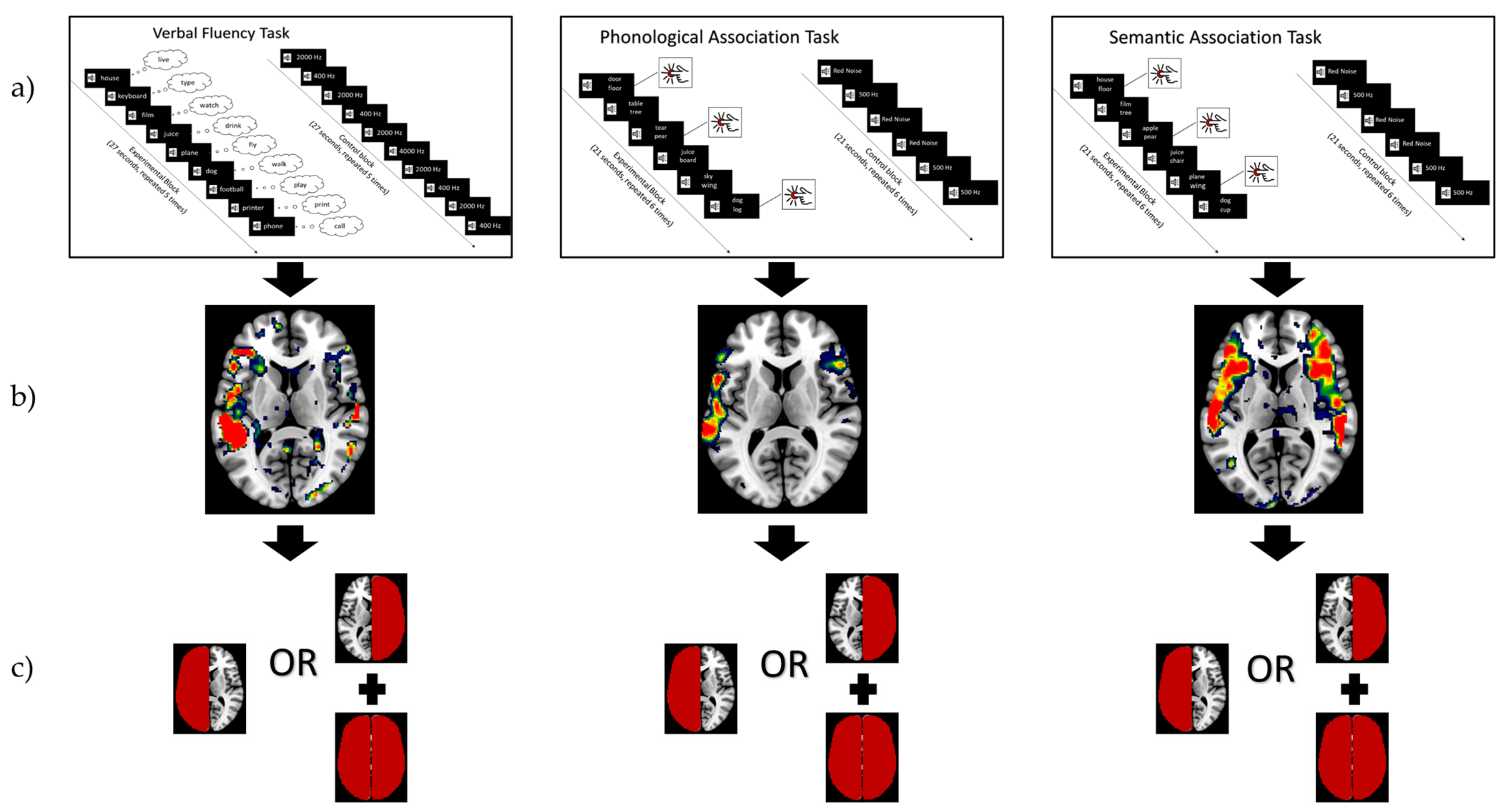
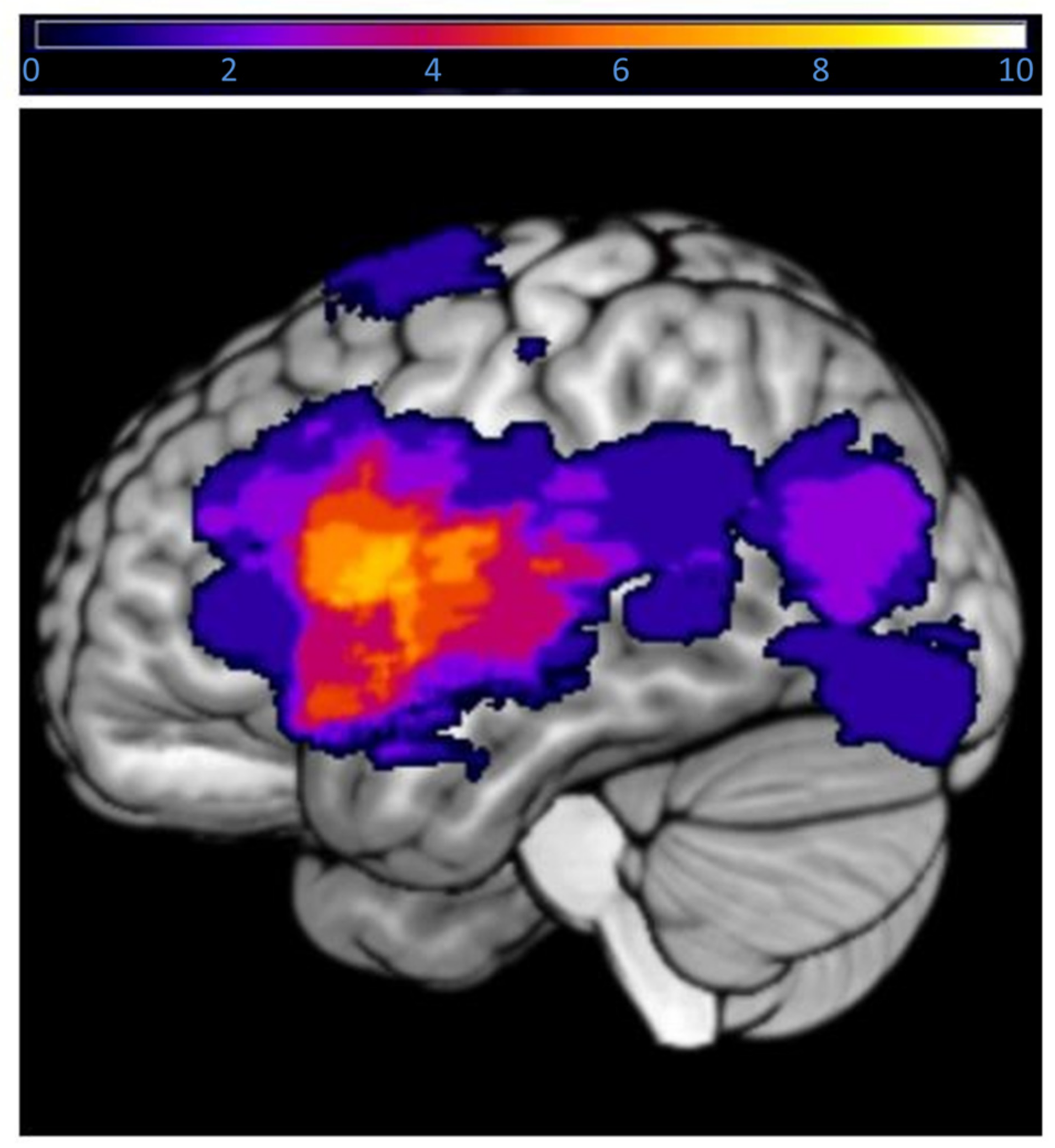
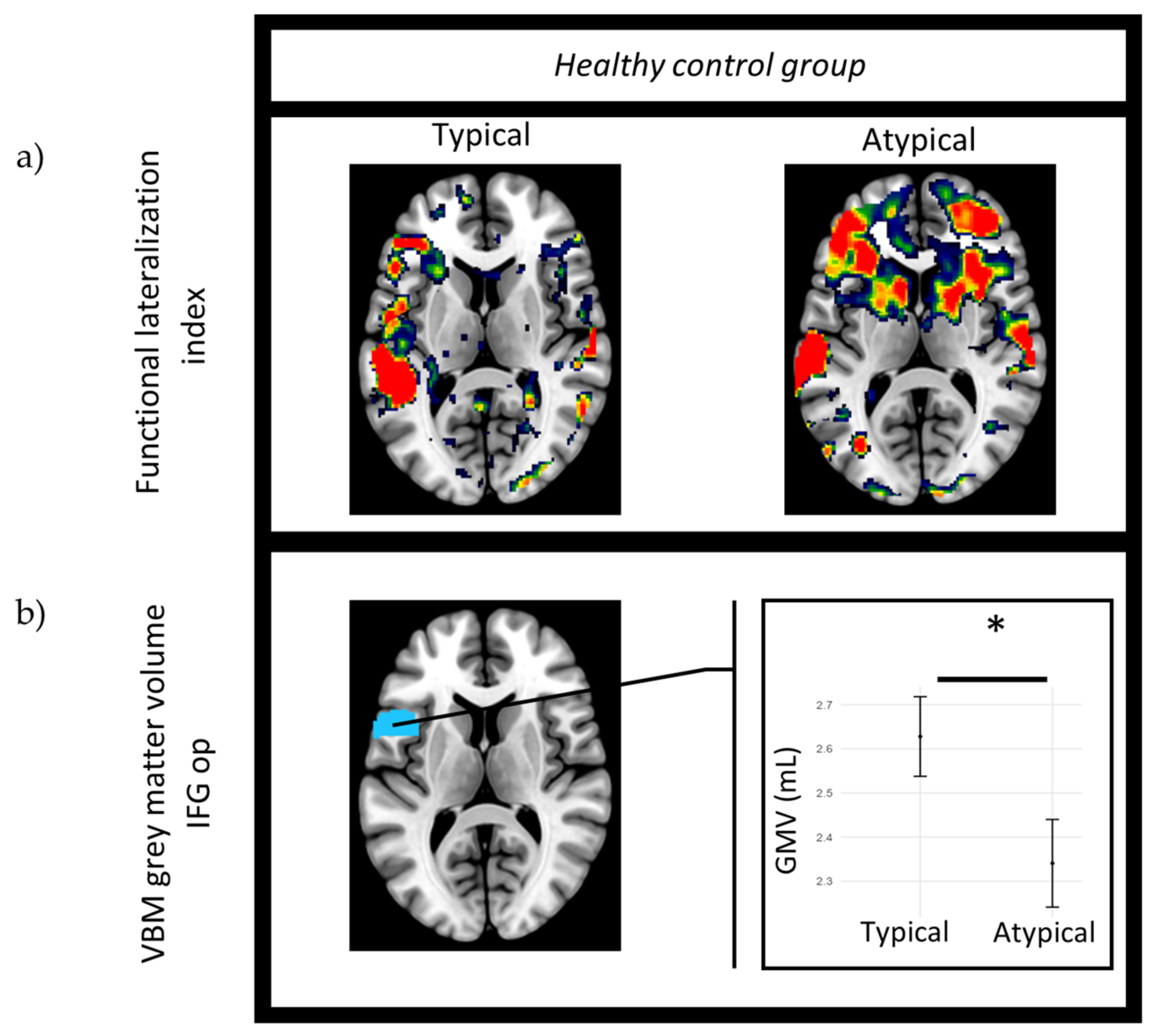
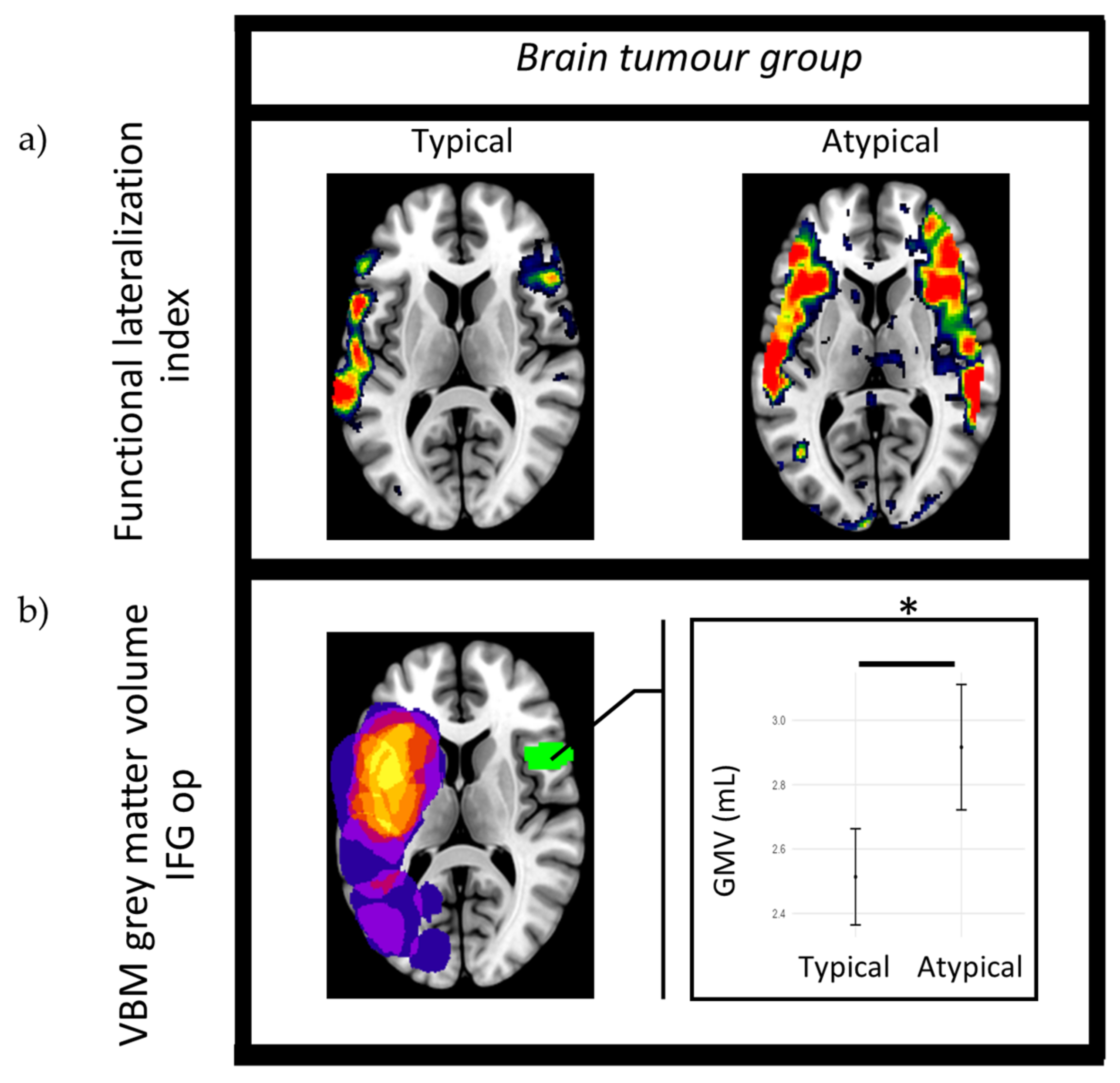
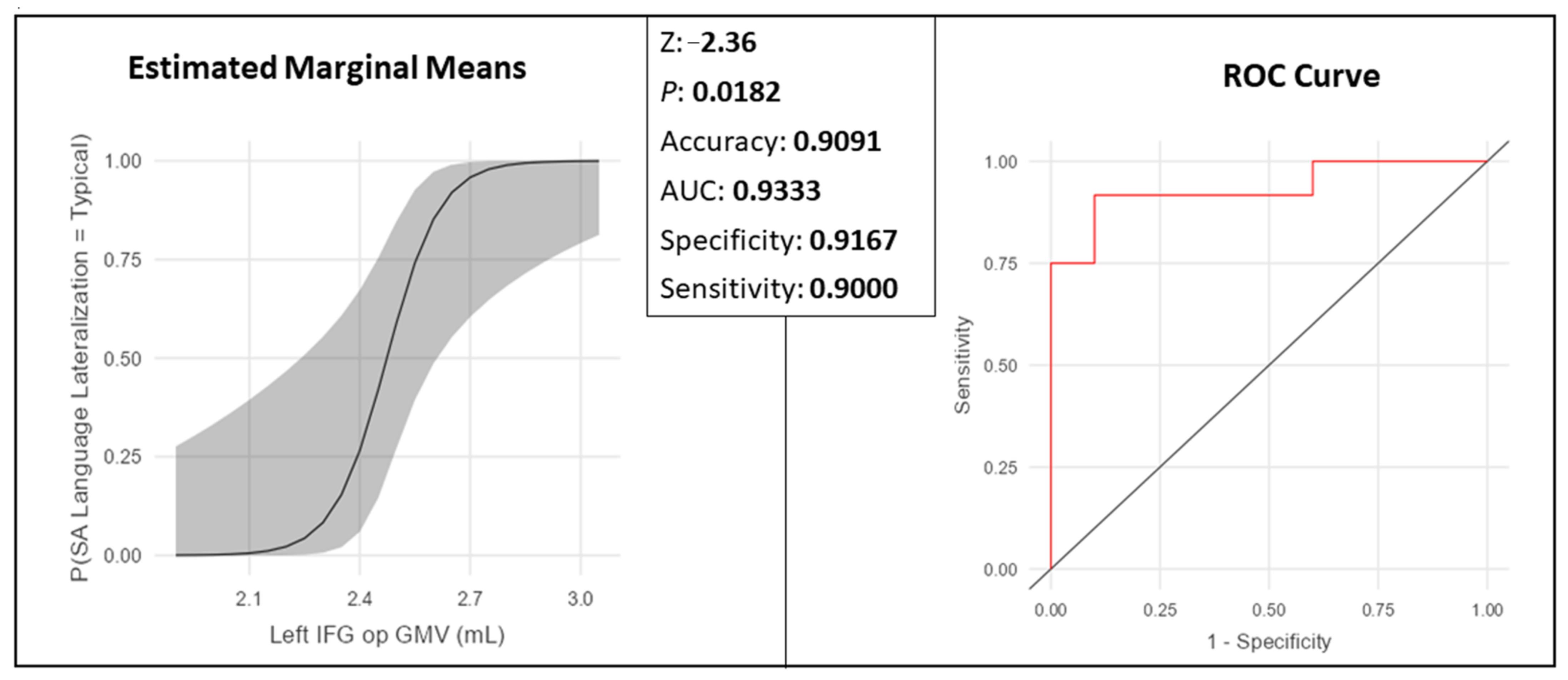
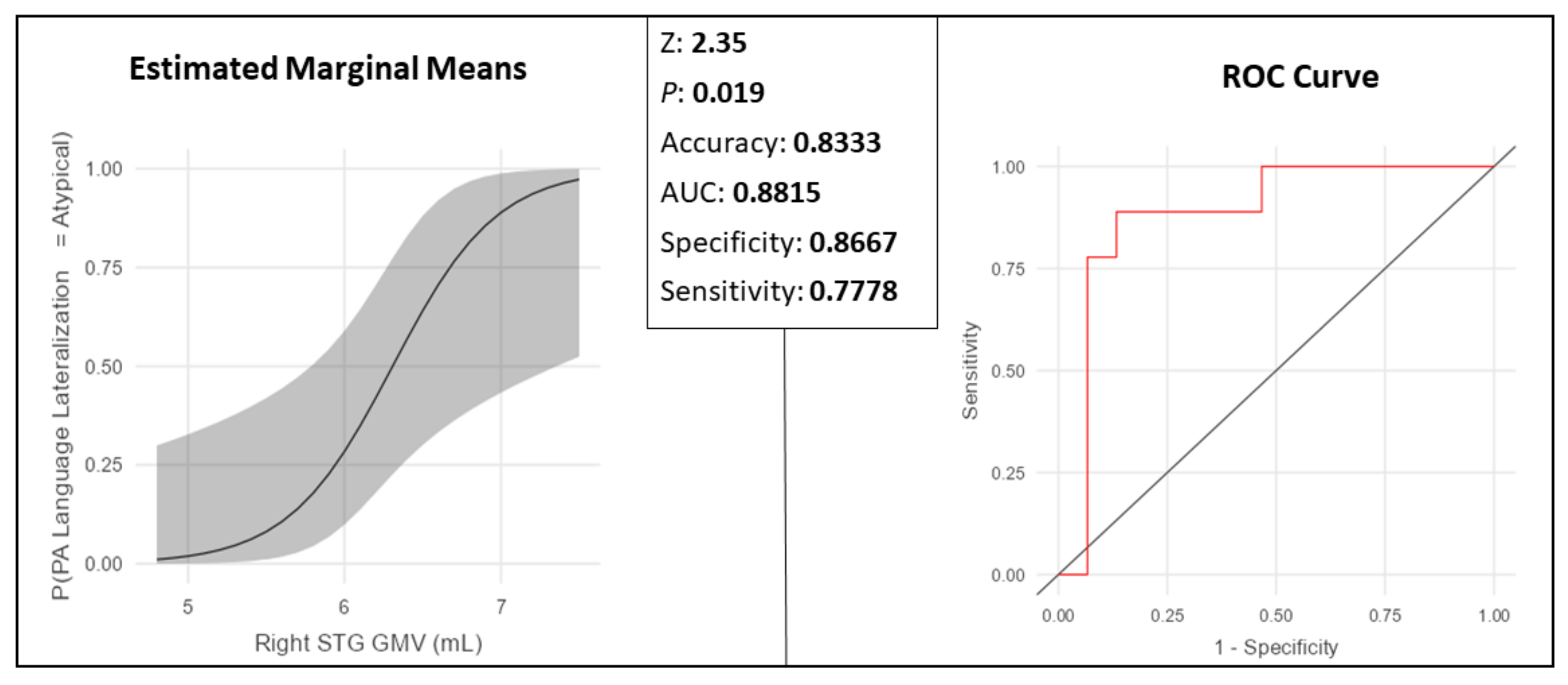
| Healthy Participant Group (N = 22) | Tumor Participant Group (N = 28) | |||||||
|---|---|---|---|---|---|---|---|---|
| PA task | PA task | |||||||
| Typical | Atypical | ) | p | Typical | Atypical | ) | p | |
| N | 11 | 11 | 15 | 9 | ||||
| Age (years) | 41.6 ± 14.7 | 41.1 ± 19.9 | 0.10 | 0.95 | 45 ± 14.6 | 42.1 ± 17.8 | 0.43 | 0.67 |
| TIV (mL) | 1498.0 ± 100.8 | 1386.9 ± 141.0 | 2.13 | 0.05 * | 1403.8 ± 189.9 | 1374.3 ± 118.0 | 0.41 | 0.68 |
| Tumor Volume (mL) | N/A | N/A | N/A | N/A | 101.8 ± 166.7 | 48.1 ± 51.0 | 0.94 | 0.36 |
| Sex (M/F) | 6/4 | 4/7 | 0.73 | 0.39 | 4/11 | 5/4 | 2.00 | 0.16 |
| Handedness (L/R) | 4/7 | 2/9 | 0.92 | 0.34 | 0/15 | 1/8 | 1.74 | 0.19 |
| SA task | SA task | |||||||
| Typical | Atypical | ) | p | Typical | Atypical | ) | p | |
| N | 12 | 10 | 18 | 10 | ||||
| Age (years) | 42.8 ± 17.9 | 39.6 ± 16.8 | 0.42 | 0.68 | 44.0 ± 14.5 | 44.9 ± 18.0 | −0.14 | 0.89 |
| TIV (mL) | 1481.3 ± 129.2 | 1395.9 ± 127.0 | 1.56 | 0.14 | 1387.5 ± 179.5 | 1417.3 ± 128.2 | −0.46 | 0.65 |
| Tumor Volume (mL) | N/A | N/A | N/A | N/A | 95.5 ± 153.8 | 40.2 ± 46.3 | 1.1 | 0.28 |
| Sex (M/F) | 7/5 | 3/7 | 1.77 | 0.19 | 6/12 | 5/5 | 0.75 | 0.39 |
| Handedness (L/R) | 4/8 | 2/8 | 0.49 | 0.48 | 0/18 | 1/9 | 1.87 | 0.17 |
| VG task | VG task | |||||||
| Typical | Atypical | ) | p | Typical | Atypical | ) | p | |
| N | 14 | 8 | 17 | 7 | ||||
| Age (years) | 43.5 ± 16.2 | 37.5 ± 18.9 | 0.79 | 0.44 | 44.4 ± 16.4 | 42.9 ± 14.4 | 0.21 | 0.84 |
| TIV (mL) | 1432.7 ± 119.4 | 1459.5 ± 160.0 | −0.45 | 0.66 | 1384.7 ± 183.4 | 1412.4 ± 115.0 | −0.37 | 0.72 |
| Tumor Volume (mL) | N/A | N/A | N/A | N/A | 90.3 ± 156.7 | 60.8 ± 69.3 | 0.47 | 0.64 |
| Sex (M/F) | 5/9 | 5/3 | 1.47 | 0.22 | 7/10 | 2/5 | 0.34 | 0.56 |
| Handedness (L/R) | 3/11 | 3/5 | 0.66 | 0.42 | 0/17 | 1/6 | 2.53 | 0.11 |
| Healthy Participant GMV-fMRI Associations—Typical > Atypical | ||||
|---|---|---|---|---|
| ROI | Hemisphere | Task | t | p |
| Opercular inferior frontal gyrus | L | SA | −4.55 | 0.00002 * |
| Supplementary motor area | R | SA | −2.22 | 0.04 |
| Orbital inferior frontal gyrus | R | PA | −2.16 | 0.045 |
| Supramarginal gyrus | R | VG | −2.96 | 0.0082 |
| Supramarginal gyrus | L | VG | −2.47 | 0.024 |
| Superior temporal gyrus | R | VG | −2.50 | 0.022 |
| Superior temporal gyrus | L | VG | −2.25 | 0.038 |
| Angular gyrus | L | VG | −2.18 | 0.043 |
| Tumor Participant GMV-fMRI Associations—Atypical > Typical | ||||
|---|---|---|---|---|
| ROI | Hemisphere | Task | t | p |
| Medial temporal gyrus | R | SA | 2.62 | 0.015 * |
| Supramarginal gyrus | R | SA | 2.90 | 0.008 * |
| Opercular inferior frontal gyrus | R | SA | 2.09 | 0.048 |
| Superior temporal gyrus | R | SA | 2.48 | 0.021 |
| Angular gyrus | R | SA | 2.42 | 0.024 |
| Opercular inferior frontal gyrus | R | PA | 3.38 | 0.003 * |
| Triangular inferior frontal gyrus | R | PA | 2.72 | 0.014 * |
| Superior temporal gyrus | R | PA | 2.96 | 0.008 * |
| Angular gyrus | R | PA | 3.01 | 0.007 * |
| Supramarginal gyrus | R | PA | 2.80 | 0.011 * |
Disclaimer/Publisher’s Note: The statements, opinions and data contained in all publications are solely those of the individual author(s) and contributor(s) and not of MDPI and/or the editor(s). MDPI and/or the editor(s) disclaim responsibility for any injury to people or property resulting from any ideas, methods, instructions or products referred to in the content. |
© 2024 by the authors. Licensee MDPI, Basel, Switzerland. This article is an open access article distributed under the terms and conditions of the Creative Commons Attribution (CC BY) license (https://creativecommons.org/licenses/by/4.0/).
Share and Cite
Solomons, D.; Rodriguez-Fernandez, M.; Mery-Muñoz, F.; Arraño-Carrasco, L.; Costabal, F.S.; Mendez-Orellana, C. Assessing Language Lateralization through Gray Matter Volume: Implications for Preoperative Planning in Brain Tumor Surgery. Brain Sci. 2024, 14, 954. https://doi.org/10.3390/brainsci14100954
Solomons D, Rodriguez-Fernandez M, Mery-Muñoz F, Arraño-Carrasco L, Costabal FS, Mendez-Orellana C. Assessing Language Lateralization through Gray Matter Volume: Implications for Preoperative Planning in Brain Tumor Surgery. Brain Sciences. 2024; 14(10):954. https://doi.org/10.3390/brainsci14100954
Chicago/Turabian StyleSolomons, Daniel, Maria Rodriguez-Fernandez, Francisco Mery-Muñoz, Leonardo Arraño-Carrasco, Francisco Sahli Costabal, and Carolina Mendez-Orellana. 2024. "Assessing Language Lateralization through Gray Matter Volume: Implications for Preoperative Planning in Brain Tumor Surgery" Brain Sciences 14, no. 10: 954. https://doi.org/10.3390/brainsci14100954
APA StyleSolomons, D., Rodriguez-Fernandez, M., Mery-Muñoz, F., Arraño-Carrasco, L., Costabal, F. S., & Mendez-Orellana, C. (2024). Assessing Language Lateralization through Gray Matter Volume: Implications for Preoperative Planning in Brain Tumor Surgery. Brain Sciences, 14(10), 954. https://doi.org/10.3390/brainsci14100954







